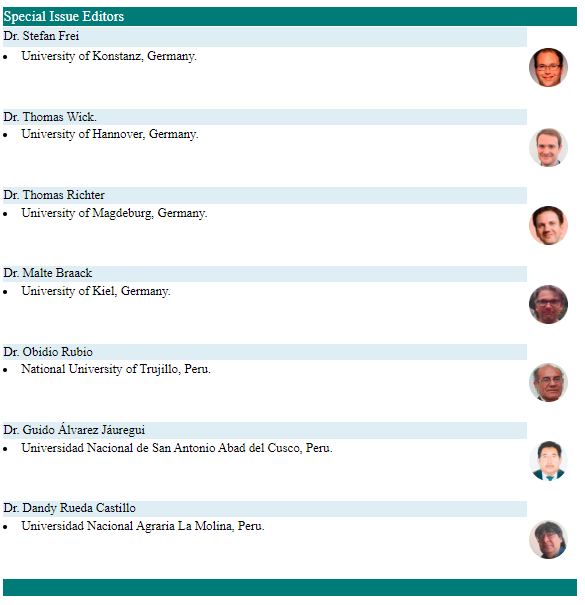Implications of the delayed feedback effect on the stability of a SIR epidemic model
DOI:
https://doi.org/10.17268/sel.mat.2023.01.03Palavras-chave:
Ordinary differential equation, feedback effect, Stability, SimulationResumo
A basic mathematical model in epidemiology is the SIR (Susceptible–Infected–Removed) model, which is commonly used to characterize and study the dynamics of the spread of some infectious diseases. In humans, the time scale of a disease can be short and not necessarily fatal, but in some animals (for example, insects) this same short time scale can make the disease fatal if we take into account their life expectancy. In this work, we will see how a positive feedback effect (decrease of the susceptible population at small densities) in a SIR model can cause a qualitative characterization of the dynamics defined by the original SIR model. Finally, we will also show with numerical simulations how a delay in the feedback effect causes very interesting qualitative changes of the system with epidemiological significance.
Referências
Goel K. Stability behavior of a nonlinear mathematical epidemic transmission model with time delay. Nonlinear Dynamics. 2019 Oct;98(2):1501-18.
López-Cruz R. Global stability of an SAIRD epidemiological model with negative feedback. Advances in Continuous and Discrete Models. 2022 Dec;2022(1):1-3.
Hilker FM, Langlais M, Malchow H. The Allee effect and infectious diseases: extinction, multistability, and the (dis-) appearance of oscillations. The American Naturalist. 2009 Jan;173(1):72-88.
Hilker FM. Population collapse to extinction: the catastrophic combination of parasitism and Allee effect. Journal of Biological Dynamics. 2010 Jan 1;4(1):86-101.
Lobov SA, Zharinov AI, Berdnikova ES, Kurganov DP, Kazantsev VB. Information feedback provokes multi-peak dynamics in the modern world epidemic spreads. Research Square; 2022. DOI: 10.21203/rs.3.rs-1496894/v1.
Lv Y, Chen L, Chen F, Li Z. Stability and bifurcation in an SI epidemic model with additive Allee effect and time delay. International Journal of Bifurcation and Chaos. 2021 Mar 30;31(04):2150060.
Thieme HR, Dhirasakdanon T, Han Z, Trevino R. Species decline and extinction: synergy of infectious disease and Allee effect?. Journal of Biological Dynamics. 2009 May 1;3(2-3):305-23.
Usaini S, Lloyd AL, Anguelov R, Garba SM. Dynamical behavior of an epidemiological model with a demographic Allee effect. Mathematics and Computers in Simulation. 2017 Mar 1;133:311-25.
Guo ZG, Li J, Li C, Liang J, Yan Y. Pattern Dynamics of Nonlocal Delay SI Epidemic Model with the Growth of the Susceptible following Logistic Mode. Complexity. 2020 Jul 26;2020.
Zhang FF, Jin Z, Sun GQ. Bifurcation analysis of a delayed epidemic model. Applied Mathematics and Computation. 2010 Apr 1;216(3):753-67.
Fukuda I, Kiri Y, SaitoW, Ueda Y. Stability Criteria for the System of Delay Differential Equations and its Applications. Osaka Journal of Mathematics. 2022 Jan;59(1):235-51.
Hu GD, Hu GD, Cahlon B. Algebraic criteria for stability of linear neutral systems with a single delay. Journal of Computational and Applied mathematics. 2001 Oct 1;135(1):125-33.
Song Y, Han M, Wei J. Stability and Hopf bifurcation analysis on a simplified BAM neural network with delays. Physica D: Nonlinear Phenomena. 2005 Jan 15;200(3-4):185-204.
Blower SM, Dowlatabadi H. Sensitivity and uncertainty analysis of complex models of disease transmission: an HIV model, as an example. International Statistical Review/Revue Internationale de Statistique. 1994 Aug 1:229-43.
Marino S, Hogue IB, Ray CJ, Kirschner DE. A methodology for performing global uncertainty and sensitivity analysis in systems biology. Journal of theoretical biology. 2008 Sep 7;254(1):178-96.
McKay MD, Beckman RJ, Conover WJ. A comparison of three methods for selecting values of input variables in the análisis of output from a computer code. Technometrics. 2000 Feb 1;42(1):55-61.
Iman RL, Helton JC. An investigation of uncertainty and sensitivity analysis techniques for computer models. Risk analysis. 1988 Mar;8(1):71-90.
Downloads
Publicado
Como Citar
Edição
Seção
Licença
Copyright (c) 2023 Selecciones Matemáticas

Este trabalho está licenciado sob uma licença Creative Commons Attribution 4.0 International License.
Os autores que publicam nesta revista aceitam as seguintes condições:
Os autores mantêm os direitos autorais e atribuem à revista o direito da primeira publicação, com o trabalho registrado com a licença de atribuição Creative Commons Atribución 4.0 Internacional (CC BY 4.0), que permite que terceiros usem o material publicado sempre que mencionarem a autoria do trabalho e os direitos autorais. Primeira publicação nesta revista.
Os autores podem fazer outros acordos contratuais independentes e adicionais para a distribuição não exclusiva da versão do artigo publicada nesta revista (por exemplo, incluí-la em um repositório institucional ou publicá-la em um livro), desde que afirme claramente que o trabalho Foi publicado nesta revista.
É permitido e recomendado aos autores que publiquem seus trabalhos na Internet (por exemplo, em páginas institucionais ou pessoais) antes e durante o processo de revisão e publicação, pois isso pode levar a trocas produtivas e a uma disseminação maior e mais rápida do trabalho. publicado (Consultar: efeito do acesso aberto).












